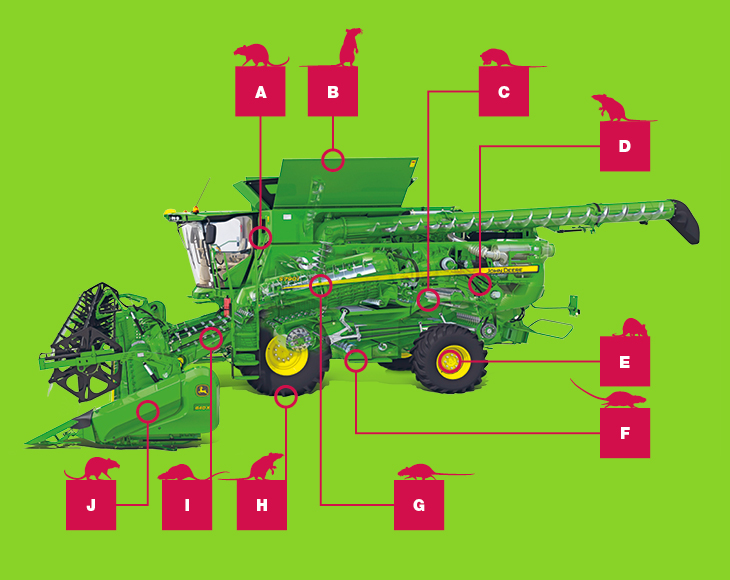
We’ve teamed up with John Deere to produce this guide to protect your machinery over the winter months.
Author
| 16th September 2019How to protect your combine harvester from rodents
How big is the risk?
Rodents pose a huge threat to machinery stored inactive over winter. Combines are at greatest risk, potentially harbouring food sources and providing shelter.
With new combines easily worth a quarter of a million pounds, the fire risk posed by rodents gnawing electrical wiring must not be underestimated. Wiring, hydraulic hoses, drive belts and electrical components are particularly at risk, so damage can be expensive and often goes unnoticed until the following season when the machine is next required.
An integrated approach in 7 steps
New rules governing permanent baiting mean an integrated approach to rodent control is needed from the outset.
1. Before putting a machine into storage it should be thoroughly cleaned and all harvest debris and grain removed.
2. Ensure the building perimeter is free from debris, undergrowth and general rubbish to make it less attractive to rodents.
3. Once the machine is stored, check it for rodent activity regularly. If rodent activity is seen, a baiting plan should be implemented immediately.
4. Start and run the combine at regular intervals to disturb any rodents within the machine
5. Use a block or soft block formulation for baiting. They are easy to place, secure and can easily be recovered and reused at the end of a baiting programme.
6. Make sure the bait is secure as rats are hoarders.
7. Follow label instructions and Campaign for Responsible Rodenticide Use (CRRU) stewardship guidelines.
Where to place rodent bait

A. Put bait behind the cab to protect cabling
B. Secure bait on the roof engine bay to prevent rodents chewing pipes and cables
C. Access points of any fans should be baited with secure blocks
D. Place a bait box or blocks secured with wire to the combine sieve
E. Put a bait box on both rear axles to prevent nesting
F. If inspection panels on clean grain and returns elevators are open, attach bait blocks to each to prevent rodents gnawing rubber paddles
G. Secure a bait block close to the hydraulic controls and wiring on the left side of the combine – ensure it cannot fall and hang, which prevents rodent ingestion
H. Install bait boxes with secure bait blocks at the base of each wheel to reduce access points
I. Both sides of the feeder housing should be baited to prevent chewing of cables and belts
J. Attach blocks to the header driver line to protect cables and belts
This blog is based on an article from the autumn ‘19 issue of Crop Focus magazine. The magazine is packed full of insight, advice and research from the world of arable farming to help you grow the most profitable crops possible. Over 90% of readers find Crop Focus an interesting read – it’s free to subscribe so sign-up today!